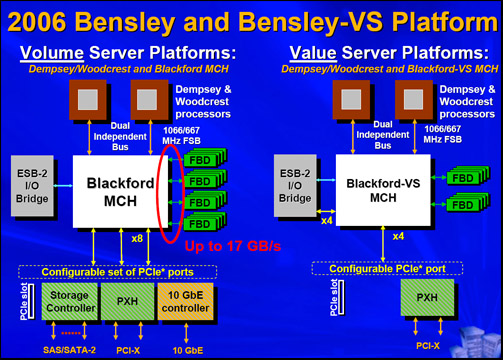Intel’s Dual-Core Xeon First Look
by Jason Clark & Ross Whitehead on December 16, 2005 12:05 AM EST- Posted in
- IT Computing
More processing power has long been the focus of the processor giants, but times are changing. Performance per Watt is the focus for both AMD & Intel for the foreseeable future.
In October of this year, Intel invited AnandTech to its Jones Farm Campus in Portland Oregon. The purpose of the visit was to get a detailed overview of their roadmap for the next year, and to take a close look at the Bensley platform. Bensley is the code name for Intel's new Xeon platform, which will support both Dempsey and Woodcrest processors and a new chipset, code-named Blackford. Demspey is going to take us well into Q2 of next year, and Woodcrest will appear sometime in the second half of next year. Woodcrest will be a lower wattage part that is focused on performance per Watt.
Dempsey is the processor that we're going to take a look at in this article. What we'll be showing benchmarks on is a pre-production Bensley platform. Performance may differ once the platform reaches production status. The key features of Dempsey are: dual-core support, 65nm fabrication and an Independent L2 2MB Cache (2x2MB). Intel will release three variations of the Dempsey processor: a 1066 MHz FSB (130W) version that is the "Performance" version, a 1066 MHz FSB (95W) version that is a rack-optimized part (perf/power for rack density) and a 667 MHz FSB (95W) value version.
The Blackford chipset is all new for Xeon, and addresses one of the main bottlenecks that we've seen in previous Xeon chipsets, front side-bus. Blackford uses a dual independent bus architecture operating at 1066MHz. Memory is now FBD-DDR2 (Fully Buffered DIMM) running at 533MHz, which offers up to 17GB/s of memory bandwidth.
Bensley Platform Diagram
In October of this year, Intel invited AnandTech to its Jones Farm Campus in Portland Oregon. The purpose of the visit was to get a detailed overview of their roadmap for the next year, and to take a close look at the Bensley platform. Bensley is the code name for Intel's new Xeon platform, which will support both Dempsey and Woodcrest processors and a new chipset, code-named Blackford. Demspey is going to take us well into Q2 of next year, and Woodcrest will appear sometime in the second half of next year. Woodcrest will be a lower wattage part that is focused on performance per Watt.
Dempsey is the processor that we're going to take a look at in this article. What we'll be showing benchmarks on is a pre-production Bensley platform. Performance may differ once the platform reaches production status. The key features of Dempsey are: dual-core support, 65nm fabrication and an Independent L2 2MB Cache (2x2MB). Intel will release three variations of the Dempsey processor: a 1066 MHz FSB (130W) version that is the "Performance" version, a 1066 MHz FSB (95W) version that is a rack-optimized part (perf/power for rack density) and a 667 MHz FSB (95W) value version.
The Blackford chipset is all new for Xeon, and addresses one of the main bottlenecks that we've seen in previous Xeon chipsets, front side-bus. Blackford uses a dual independent bus architecture operating at 1066MHz. Memory is now FBD-DDR2 (Fully Buffered DIMM) running at 533MHz, which offers up to 17GB/s of memory bandwidth.
Bensley Platform Diagram











67 Comments
View All Comments
coldpower27 - Friday, December 16, 2005 - link
And I am interested how did you get a difference of $8140 to begin with.Furen - Friday, December 16, 2005 - link
I took a lot of shortcuts just to get a rough approximation but here it goes:406W - 260W = 166W
166W * 24H/day = 3984WH/day
3984WH/day * 365 days = 1,454,160WH/year = 1,454kWH/year
1,454kWH/year * $.14/kWH (which is overpriced, by the way, since consumers normally pay more than businesses) = $203.58/year
$203.58/year * 40 systems = $8143.30/year for 40 systems.
Viditor - Friday, December 16, 2005 - link
Good point...forgot about the power conversion and power supply loss.Furen - Friday, December 16, 2005 - link
I didn't mean PSU power loss, but rather that many data centers convert the AC input to DC at the distribution centers and the convert it to AC again just before sending it to the server, since servers are not built to operate on DC.PSU loss is already reflected in anadtech's measurements, since power consumption is measured at the plug.
Furen - Friday, December 16, 2005 - link
man, I would kill for an edit function on comments...Viditor - Friday, December 16, 2005 - link
You're forgetting the cost of cooling (which is much higher than just the CPU...)
coldpower27 - Friday, December 16, 2005 - link
They are measuring total power draw of the 2 systems which includes the energy used by the cooling system. I am not forgeting anything. I am only interested in cost of electricity used by the 2 systems.
Anandtech isn't incorporating cost of cooling into it's numbers either.
Jason Clark - Friday, December 16, 2005 - link
If we had complete systems from both vendors, this would have been possible. Unfortunately, we had a pre-production validation platform and a motherboard and two cpus from amd :)... So, what we did was make the bensley system as close to the open air opteron system as we could. I agree, we need to get some complete systems with their cooling mechanisms in place, and we'll work on the vendors next year for that.Viditor - Friday, December 16, 2005 - link
The cooling systems I refer to are the airconditioning, not the HSF or the case fans...By doubling the heat output, you are also doubling the air con requirements.
coldpower27 - Friday, December 16, 2005 - link
Which would be offset by the heating provided in the Winter time.